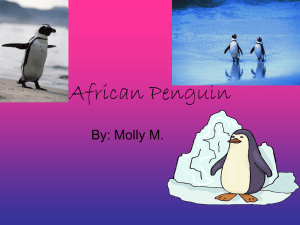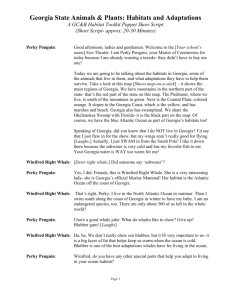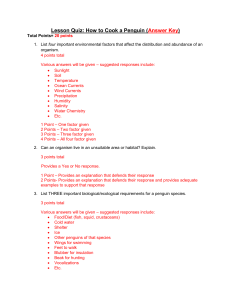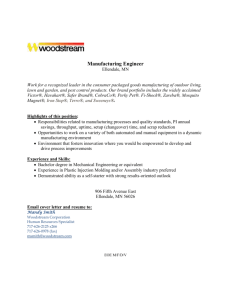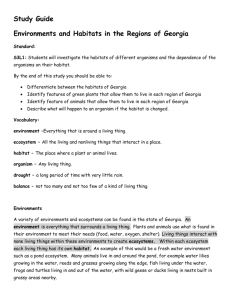Habitat Toolkit: Play Script - Gwinnett Clean and Beautiful
advertisement
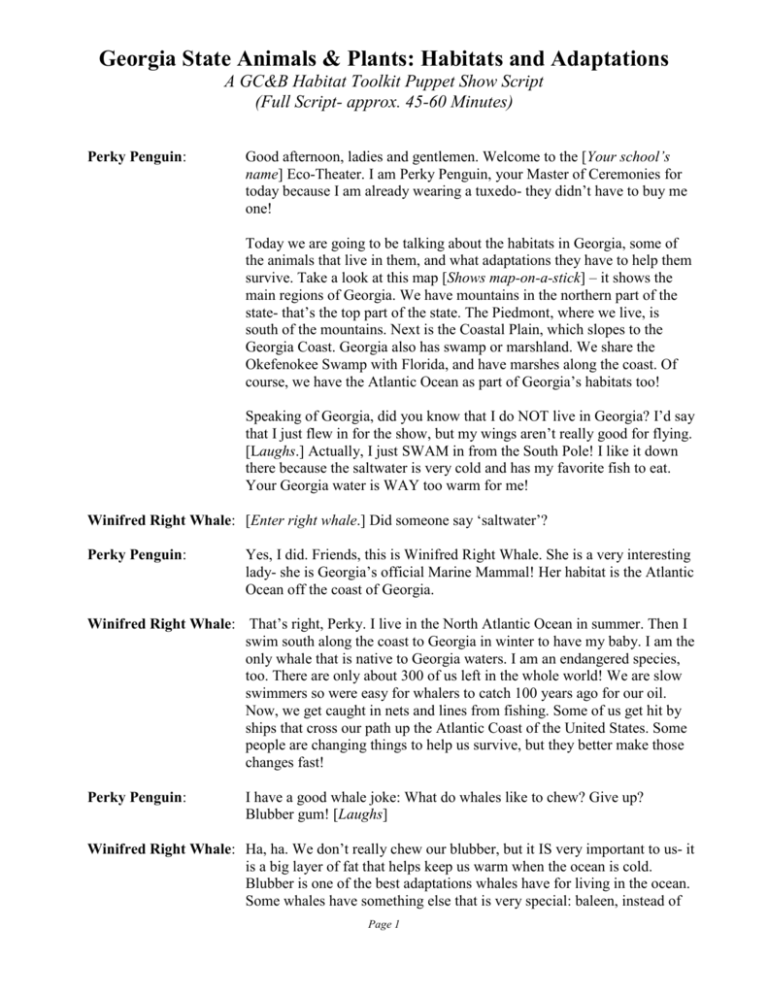
Georgia State Animals & Plants: Habitats and Adaptations A GC&B Habitat Toolkit Puppet Show Script (Full Script- approx. 45-60 Minutes) Perky Penguin: Good afternoon, ladies and gentlemen. Welcome to the [Your school’s name] Eco-Theater. I am Perky Penguin, your Master of Ceremonies for today because I am already wearing a tuxedo- they didn’t have to buy me one! Today we are going to be talking about the habitats in Georgia, some of the animals that live in them, and what adaptations they have to help them survive. Take a look at this map [Shows map-on-a-stick] – it shows the main regions of Georgia. We have mountains in the northern part of the state- that’s the top part of the state. The Piedmont, where we live, is south of the mountains. Next is the Coastal Plain, which slopes to the Georgia Coast. Georgia also has swamp or marshland. We share the Okefenokee Swamp with Florida, and have marshes along the coast. Of course, we have the Atlantic Ocean as part of Georgia’s habitats too! Speaking of Georgia, did you know that I do NOT live in Georgia? I’d say that I just flew in for the show, but my wings aren’t really good for flying. [Laughs.] Actually, I just SWAM in from the South Pole! I like it down there because the saltwater is very cold and has my favorite fish to eat. Your Georgia water is WAY too warm for me! Winifred Right Whale: [Enter right whale.] Did someone say ‘saltwater’? Perky Penguin: Yes, I did. Friends, this is Winifred Right Whale. She is a very interesting lady- she is Georgia’s official Marine Mammal! Her habitat is the Atlantic Ocean off the coast of Georgia. Winifred Right Whale: That’s right, Perky. I live in the North Atlantic Ocean in summer. Then I swim south along the coast to Georgia in winter to have my baby. I am the only whale that is native to Georgia waters. I am an endangered species, too. There are only about 300 of us left in the whole world! We are slow swimmers so were easy for whalers to catch 100 years ago for our oil. Now, we get caught in nets and lines from fishing. Some of us get hit by ships that cross our path up the Atlantic Coast of the United States. Some people are changing things to help us survive, but they better make those changes fast! Perky Penguin: I have a good whale joke: What do whales like to chew? Give up? Blubber gum! [Laughs] Winifred Right Whale: Ha, ha. We don’t really chew our blubber, but it IS very important to us- it is a big layer of fat that helps keep us warm when the ocean is cold. Blubber is one of the best adaptations whales have for living in the ocean. Some whales have something else that is very special: baleen, instead of Page 1 Georgia State Animals & Plants: Habitats and Adaptations A GC&B Habitat Toolkit Puppet Show Script- Full Script teeth. Even though we are very big- about as long as a school bus- right whales eat very tiny creatures called plankton and krill. Krill are tiny shrimp-like animals- yummy! How would I ever get full if I had to catch them one at a time? My baleen helps me to eat a LOT at one time- up to 4,000 pounds of food every day! Perky Penguin: How does your baleen do that? Winifred Right Whale: Baleen is sort of like a bunch of combs hanging down in my mouth- you know, like the combs you use for your hair. When I find a lot of my favorite foods, I open my giant mouth. I scoop up a large amount of water, which also pulls a lot of the tiny plankton, krill, and fish into my mouth. Then I partly close my mouth and push my tongue to the top. You try it too! That pushes the water out through the open parts of the baleen, like a strainer. All the little critters stay in my mouth behind the baleen, and I swallow them. Double yummy! Perky Penguin: Winifred, that’s a pretty good adaptation to help a large creature get enough food even though the food is very small. Do you have any other special parts that help you adapt to living in your ocean habitat? Winifred Right Whale: Oh yes. Look at my long narrow shape. It helps me glide through the water without having to do a lot of work swimming. I also have a big tail, called a ‘fluke’ that helps me to swim. [Wiggles tail.] I can make sounds too- I call to my whale friends and family so that we can hunt together. Sometimes we just stay together for safety, especially when we have babies. Oh, I hear them calling for me now- see you later! [Swims off.] Perky Penguin: Good-bye, Winifred! [Watches tortoise walk slowly in.] Here’s an excuse for another joke. What was the tortoise doing on the highway? Give up? About 5 inches per hour! Har, har, har! Tamara Tortoise: That’s really not funny- tortoises and turtles do not belong on a highway. We can get hurt there! Perky Penguin: You are absa-turtle-lutely right about that! Folks, this is Tamara Tortoise. She is a Gopher Tortoise, the Georgia State Reptile. Tell us a little about yourself, Tamara. Tamara Tortoise: Well, Perky, my kind of tortoise has been around for over 60 million years. We have a lot of adaptations that help us live in the southern coastal plain of Georgia. It gets pretty hot in the habitat we like, so we make our homes in burrows that we dig. See my big claws and flat front legs? Those are a special adaptation that only some tortoises have. I use them to dig in sandy soil. My front feet and legs are like shovels! Page 2 Georgia State Animals & Plants: Habitats and Adaptations A GC&B Habitat Toolkit Puppet Show Script- Full Script Perky Penguin: Do you have any other special adaptations? Tamara Tortoise: The burrow I dig as my special home is an adaptation. My burrow can be 10 feet deep and up to 40 feet wide. It’s so big that other animals can live there too! Because my burrow is so deep, the temperature stays about the same all year. It doesn’t matter if it is hot or cold outside. It also has high humidity- that is the opposite of being dry. When it is too hot and dry ‘on top’, I can go down to my burrow and stay at just the right temperature and not get too dried out. My burrow is my favorite part of my habitat. Remember, there’s “No place like home!” That’s why I always carry an extra one with me! [Tortoise walks off.] Perky Penguin: Speaking of ‘home,’ friends, I’ve got another joke: What’s green and slimy and found at the North Pole? Ready? ...a lost frog! [Laughs] Freddie Tree Frog: [Green Tree Frog enters.] Hey, I don’t think that’s very funny- a frog is cold-blooded. We might freeze to death at the North Pole! Perky Penguin: I guess that’s true. Sorry. Folks, I’d like to introduce you to Freddie Tree Frog, the Georgia State Amphibian. The green tree frog was actually chosen by a class of students. The class hoped the frog would help people realize that we have to stop polluting the water frogs live in. See, kids CAN make a difference! Freddie Tree Frog: That’s right, Perky, kids can do a lot to help the world we live in. You might find some of my green tree frog cousins in your backyard. You could find a lot of us after a rainstorm! I live in parts of all the Georgia regions, but especially southern Georgia and the Piedmont. You might see me going after ‘fast food’ too. I like to hang around by your porch lights to catch the flying insects they attract. Perky Penguin: That’s a great adaptation, Freddie, for an animal whose habitat now includes where humans have THEIR habitats. Freddie Tree Frog: [Nods head ‘yes.’] Perky, I also have a special tongue. It is a super adaptation for someone who loves to eat flying bugs. My tongue is very long and I can flick it out to catch bugs as they fly by. My tongue is sticky to hold bugs on my tongue until I can get them back to my mouth. I can do that pretty fast. Don’t blink or you just might miss it. Perky Penguin: Now that’s FAST fast food! Freddie Tree Frog: I like to live in habitats that are wet- near ponds, wetlands, creeks, even swimming pools. My skin is very special, because I use it for breathing. That’s why I have to stay wet. Some of the oxygen I breathe is dissolved in the water on my skin. I can also change the color of my skin to camouflage myself and hide. If you see me at night, I might be a dark olive green tree frog. During the day, I might change to bright green so Page 3 Georgia State Animals & Plants: Habitats and Adaptations A GC&B Habitat Toolkit Puppet Show Script- Full Script you can’t see me in the bright sunshine on the leaves. I might even have spots to hide better. Pretty good adaptations, right? Perky Penguin: Those are some great adaptations! Freddie Tree Frog: I have another adaptation to help me climb trees. See the little pads I have on my toes? They also have sticky on them. I can easily climb up a tree or tall plant when I am looking for a meal, because my toes stick! It helps me jump from one place and safely land on another, too. Perky Penguin: I’m glad you mentioned jumping, as I have another joke: “What’s green and can jump a mile a minute? It’s…a frog with hiccups!” Ha, Ha Ha. Freddie Tree Frog: Perky, that joke is older than dirt. So I think I’ll be heading back to the pond and some wet dirt…See you later. Perky Penguin: [To audience.] Hmmm….I wonder if Georgia has a state mammal. Penelope Possum: [Possum enters.] Well, hello there Perky. I’m Penelope Possum, and this is my baby. I do have an answer to your question. Actually, no, there is no state mammal- yet. But Pogo is a Georgia state symbol. Pogo was a comic strip character. He was an opossum that lived in Georgia’s Okefenokee Swamp. Pogo is best known for a comic that showed the forest all littered with trash, and he said “We have met the enemy, and he is us.” Perky Penguin: Wow, that is pretty deep. I guess that means we need to be cleaning up all our own garbage and litter, or else we are in big trouble? Penelope Possum: That’s right, Perky. But let me tell you a little bit about ‘possums. We have some pretty special adaptations to help us survive. You can actually find us in any Georgia habitat, even the city. As long as there are trees and food, we’ll be there! We especially like it if there is a stream or swamp nearby. You probably won’t see us in the daytime, because at night is when we are awake- so we are called ‘nocturnal.’ Perky Penguin: What kind of foods do possums eat? Penelope Possum: Possums are ‘omnivores’- we eat about everything! We especially like snails, spiders, insects like roaches, rats, snakes, and mice. We like fruit and whatever food is falling out of the trash can too. We also eat carrionthat’s a fancy word for things that have already died. That makes us a part of the earth’s ‘clean-up crew.’ Liking a lot of different types of foods is a good adaptation. It makes it easy for us to live most anywhere- from the country to the city! But what about a state mammal? Perky Penguin: Penelope Possum: We possums ARE mammals. We have a special adaptation that is a pouch like a kangaroo for my babies. Mammals with a pouch for babies are Page 4 Georgia State Animals & Plants: Habitats and Adaptations A GC&B Habitat Toolkit Puppet Show Script- Full Script called ‘marsupials.’ When the babies are born, they are smaller than a green pea, and cannot take care of themselves. They crawl into my pouch and drink my milk until they are bigger. Then they ride on my back by holding on to my long fur with their claws. My babies have five toes on each foot, just like people! They even have 2 thumbs, except on their back feet instead of hands. That helps them hold onto my fur or tree branches. I teach them how to find food, a place in a tree to nest, and how to stay safe from predators. I even teach them how to use their special tail to hang upside down from a tree branch! Then, when they are grown, they can go off on their own and have their own possum family. Perky Penguin: I do have an opossum joke you might like: Why did the chicken cross the road? To show the possum it could be done! LOL. Penelope Possum: Perky, you know that one is DEFINITELY not funny- lots of possums get killed on the road at night. Drivers don’t see us in time to stop. So remember, please give possums a brake! That’s ‘B-R-A-K-E”, you know. I have to run to get my beauty sleep- Bye! [Possum exits.] Perky Penguin: [Butterfly flutters in.] Oh, here’s someone who has had a LOT of beauty sleep…a tiger swallowtail butterfly! Sammy Swallowtail: Hello Perky, and thank you for the compliment. Did you know some people call butterflies ‘flying flowers’? Perky Penguin: I can see where they would get that idea. What kind of animal are you though? Sammy Swallowtail: I am Sammy Swallowtail. A butterfly is actually a kind of insect, because I have 6 legs and a hard skeleton on the outside. I live in all the regions of Georgia because they are warm in the summer. I like woodlands, meadows, and gardens especially. I even like places like your backyard or the city, if there are some good flowers around. A-hem- AND I am the Georgia State Butterfly. Perky Penguin: Would you like to hear a butterfly riddle? Where do butterflies go to read books? At ‘branch’ libraries! Sammy Swallowtail: That IS funny, Perky. Butterflies do sit on branches, but butterflies can’t read books- they are too hard for a butterfly to hold! We use our excellent sense of smell to know where the good food is hiding. Then I use my special adaptation for food. I don’t have a jaw or a regular tongue! Instead, I have a ‘proboscis.’ That’s a flexible tube like a straw that coils up when I am not using it. I uncoil it to sip nectar- that’s the sweet juice inside the flower. Other insects like bees are too wide and can’t get to the nectar in long thin flowers. My sipping proboscis is a great adaptation that means there is more nectar for me! Page 5 Georgia State Animals & Plants: Habitats and Adaptations A GC&B Habitat Toolkit Puppet Show Script- Full Script Perky Penguin: That’s a pretty cool way to have dinner- just sip it! Sammy Swallowtail: I have another special adaptation- my coloring. Yellow in the animal world means,” Watch out!” Birds and other predators think I am poisonous. I’m really not, but they avoid me just the same. Some of the females in our species are dark like another butterfly that is VERY poisonous. That REALLY keeps predators away from the females so they can lay lots of eggs. Perky Penguin: That’s pretty smart! Sammy Swallowtail: I have one more adaptation to tell about. The habitats we like get cold in the winter, so as a caterpillar I curled up in a leaf and became a pupa. I spent the whole winter that way. Once it got warm, I finished changing into a butterfly. I crawled out of my chrysalis just in time for the blooming of the flowers that have my favorite nectar. Perky Penguin: Sammy, Tiger Swallowtail Butterflies have made some very good adaptations! Sammy Swallowtail: You are right Perky. Well, I’m getting hungry again. We have pretty small stomachs, you know. We have to keep sipping to stay full. Time to fly! [Flies off.] Perky Penguin: Wow, Sammy Swallowtail DOES look like a ‘flying flower.’ Hey, what’s this? [Azalea bush appears.] It looks like a REAL flower. Azalea Annie: Hi there. I am Azalea Annie. I AM a real flower- the Georgia State Wildflower. You can see my cousins from Japan in many yards. I am a native plant and am a little bit different. I drop my leaves every fall. If an azalea in your yard keeps its leaves, you will know it cannot be a Georgia native species. Perky Penguin: What kinds of habitats do you like, Azalea Annie? Azalea Annie: I like cool, partly shaded spots. I especially like to live under pine trees. I am somewhat fussy about where I live. That’s important because I can’t move to a better place once I have started growing in a spot. If I get too much sun my leaves will dry out. If I am in deep shade I cannot grow or flower well. Perky Penguin: Where would we find places that you like in Georgia? Azalea Annie: Mountains are one of my favorite habitats. I can grow in backyards or other places in the state if the area is just right. Page 6 Georgia State Animals & Plants: Habitats and Adaptations A GC&B Habitat Toolkit Puppet Show Script- Full Script Perky Penguin: Do you have any special adaptations that help you live in your favorite places? Azalea Annie: Of course. All plants and animals adapt to the area around them, or they don’t survive! I have shallow roots. Roots that do not go deep are perfect for thin mountain soils. Mountain soils have good drainage with all that water flowing downhill, so my roots have learned to like being a little bit moist. I don’t like my roots too wet like they could get in clay soils which are what you find in this area. Under pine trees, the soil is a little bit acidic. I have learned to like that because I like the shade under a pine tree best. Perky Penguin: So if you have just the right conditions for your adaptations, you will grow well and make lots of flowers? Azalea Annie: That’s right, Perky. That is why I have so many flowers today. Perky Penguin: OK, here’s the BIG question: Do you know any good azalea jokes, Azalea Annie? THOSE sure are hard to find. Azalea Annie: Yes, I do have an azalea joke, believe it or not. How is the letter “A” like an azalea’s flowers? Give up? They both have bees coming after them! Ha ha ha. I even have a joke about penguins: Why do penguins carry fish in their beaks? Perky Penguin: I don’t know- why, Azalea Annie? Azalea Annie: Because penguins haven’t got any pockets! Here’s another one: What do penguins have for lunch? Icebergers! One last joke: What do you call a penguin in Georgia? Can’t think of an answer? ...You call them “Lost!” Perky Penguin: Ah-hem…I must correct you- I may be a penguin. I may be in Georgia. BUT, I am definitely NOT lost! I am the Master of Ceremonies! Your other jokes, however, are pretty good, especially for an azalea. Azalea Annie: I have some other pretty good adaptations to my habitat too. In fact, I have a secret adaptation - you won’t tell the birds if I tell you? Perky Penguin: Penguin Scout’s honor- I won’t tell. Azalea Annie: OK, here’s the secret: I have kind of long branches but they are sort of open. They are perfect for the birds to hide in. So the birds come and sit on my branches all the time. Page 7 Georgia State Animals & Plants: Habitats and Adaptations A GC&B Habitat Toolkit Puppet Show Script- Full Script When my flowers make seeds, I don’t do any special things to make the seeds fly or float somewhere, like some plants do. My seeds just drop right to the ground. Then the birds see them and pick them up. They may take them somewhere and hide the seeds. They might eat them too. Then the seeds get left somewhere else in the animal’s droppings. So new plants will grow in new places. All I had to do was attract some birds to carry them away for me. Perky Penguin: Azalea Annie, that is one of the smartest adaptations I have EVER heard! Plants can be a lot smarter than I ever thought they were. [Aside, to the audience] …and a lot funnier. Her jokes were pretty good! But that’s OUR secret. [Turns back to Azalea Annie.] Azalea Annie: Glad you have finally seen the light Perky. Plants have some very interesting adaptations that animals just never think about. We DON’T just sit around like a rock. Speaking of light, it is getting pretty bright here. I am going to move on to where it is a bit shady, like I like it. See you later, Perky! [Azalea Annie exits.] Perky Penguin: Bye Annie! Ah, shade might be a good thing for this penguin here in the Georgia heat. Let me head over to that cool stream there…. Wait, who is this? [Largemouth bass appears.] Byron Bass: Hello there, penguin. Are you lost? Perky Penguin: No, no, no. I am NOT lost. I am the Master of Ceremonies for the EcoTheater. We are doing a special show on Georgia State Symbols. We are learning about the habitats they live in, plus the adaptations they use to survive. Byron Bass: Well, you have definitely come to the right place. I am Byron Largemouth Bass. I am the Georgia State Fish! Perky Penguin: Wow, I am so glad to meet you because I have one joke left, and it just happens to be a fish joke. I was so afraid I wasn’t going to get to use it. Here goes: Where do fish keep their money? Ready? In a ‘river bank!’ Har har har… Byron Bass: That is pretty funny, especially since you are talking about one of my favorite habitats. Along a beautiful, clear, Georgia river is my favorite habitat. I also like lakes, ponds, streams, even swamps, but the water must be pretty clear and not polluted. I like having lots of plants on the banks. They give me hiding places in their roots or branches hanging down in the water. I like quiet water too. You can find me in all the Georgia regions, Page 8 Georgia State Animals & Plants: Habitats and Adaptations A GC&B Habitat Toolkit Puppet Show Script- Full Script except of course the Atlantic Ocean! I need freshwater to live in, not saltwater like you or Winifred Right Whale. I am most common in the Mountain and Piedmont areas of Georgia. Perky Penguin: Can you tell us about some of your special adaptations for your habitat? Byron Bass: Sure, Perky. If you look closely, you can see that I am a dark green on my back and my sides. The color fades to off-white on my belly. That is really helpful, because if you are above me, like a fisherman, you just see the dark top that blends in with the dark water. You don’t know that I am right next to your hook, trying to sneak that worm off to set him free. A predator below me in the water will only see my light colored belly when he looks up, because it blends in with the bright sunlight above. He will be looking for some delicious largemouth bass for lunch- but he can’t tell I am here. Pretty smart, isn’t it? Perky Penguin: It sure is…wait a minute…I’m colored the same way as you- dark on one part, light on the other. When I am swimming in the water [Perky bends down like swimming] I am dark above so the seals on the ice above me cannot tell where I am. If the seal is under me in the water, when he looks up, he can’t tell if my white belly is sunlight or penguin! Awesome! Byron Bass: It sure is a good adaptation that a lot of animals use [Aside to audience] even those with birdbrains use it sometimes! I have another great adaptation. The male largemouth bass- that’s mebuilds a nest in the water. The female then lays about 3,000 eggs in the nest. She leaves because she needs a long rest after laying THAT many eggs. I stay and guard the nest from predators. When the babies hatch, they are called “fry”- maybe because all the other fish and critters think my babies are fast food, to go with McBass Burgers or something. So I try to keep the fry together in a school. I protect them the best I can. They stay in school for about a month. Then they go off on their own to learn to be the top predator in the water. Yep, I’m pretty proud of my little fries. Oh no, there go some of my more adventurous fry. I better go herd them back to the school. Nice chatting with you, Perky! [Byron Bass swims off.] Perky Penguin: Nice chatting with you, Byron Largemouth Bass. [Turns to audience.] Nice chatting with you all today too. I hope that you learned about some of your Georgia State Symbols, their habitats, and their special adaptations that help them survive. Don’t forget that all these living organisms cannot survive only with their special adaptations. It takes a very long time for an animal or plant to adapt to new conditions. It is up to you humans to help take care of the habitats for ALL animals and plants. You can do that everyday by Page 9 Georgia State Animals & Plants: Habitats and Adaptations A GC&B Habitat Toolkit Puppet Show Script- Full Script practicing the 4 Rs- reduce, reuse, and recycle. And pick up after yourself! We don’t want litter and poisons in our habitats. Well, I have liked hearing about how all these animals and plants love their habitats. I am getting homesick for my own now! Georgia is a nice place, just not the right habitat for a penguin like me. I enjoyed being your Master of Ceremonies. I am adapted to life in Antarctica, though, which is a long swim away. So, have to run- er, waddle. See you later! [Waddles off.] [Close curtain.] Page 10

